Interview: Lead Ballerina Jessica Collado Shares With Us the Behind-the-Scenes of SUMMER AND SMOKE's Premiere at the Houston Ballet
This production opens March 9th; buy your tickets now!
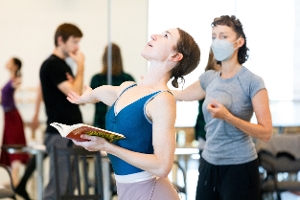
with Houston Ballet Principal Jessica Collado
Rehearsing SUMMER AND SMOKE
Photo by Lawrence Elizabeth Knox (2022),
Courtesy of Houston Ballet
Next week, Houston Ballet is presenting the premiere of Cathy Marston's SUMMER AND SMOKE, a co-production with American Ballet Theatre set to a commissioned score by Michael Daugherty. Inspired by Tennessee Williams' eponymous play, SUMMER AND SMOKE brings Marston's unique perspective on storytelling, often inspired by works of literature, to Houston audiences for the first time. Knowing the talent of the dancers with Houston Ballet as well as the technical spectacle that the company has presented recently with THE NUTCRACKER and ROMEO AND JULIET, I have no doubt that SUMMER AND SMOKE will be a spectacular and heartwarming production.
As a lover of ballet, Tennessee Williams, and storytelling, I am very excited to see this production myself next week. As a sneak-peek to the production, it was my joy to speak with Jessica Collado, one of the leads for SUMMER AND SMOKE. Through my conversation with Collado, I learned about her background, how SUMMER AND SMOKE was uniquely developed in the rehearsal room, and what we can expect from this beautiful production.
To start us off, can you tell us a little bit about yourself? What is your history with dance and the Houston Ballet?
I started dancing when I was a little girl like most little girls out there! I grew up in South Florida, and I did all sorts of dance. I grew up with a really strong contemporary jazz background when I was little. Then, my dad got a job transfer, and we moved to Georgia when I was about 13. That's when I found a studio that was predominantly ballet-focused, and I really loved ballet. So, I stuck with it through high school. During my summers when I was a teenager, I would go away to summer intensive programs such as the Boston Ballet. The Houston Ballet offered me a scholarship to come here for one summer, so I came to Houston for the first time when I was probably 14 or 15 years old. I absolutely loved it here; it was by far the hardest program I had ever been to. I felt like I grew so much as a dancer and an artist. So, I kept coming back summer after summer, and after I graduated high school, I ended up moving here and joining Houston Ballet's pre-professional company for a year. After that, I got a job in the company, and this is my 19th season with Houston Ballet. Time flies by! I love it, and I feel so fortunate to be able to do this as my career.
You have such an impressive resume. I have to ask, what has been your favorite show to be a part of in the past and/or what has been your favorite role to play throughout your time with the Houston Ballet?
Oh my goodness, that question is so hard... One of the things that I love about the Houston Ballet is the range of the repertoire that we do here. I really love contemporary works because I find that you can explore so much within them. There's a lot of room for interpretation! However, I also have this part of me that loves drama, acting, and story ballets, and we luckily do so many of those, as well. I really enjoy beautiful three-act ballets where you can become a character and get immersed in this fantasy story. Therefore, I love both ends of the spectrum when it comes to ballet genres, and it's hard to choose one ballet or one moment. There are a couple of characters that I've found that I connected with really closely. We recently did THE MERRY WIDOW, and I got to play Hanna, which was really, really special. Also, Cinderella was another role that I really, really loved as far as characters go- we are actually bringing that ballet back next season. Getting to be a part of a creation and putting your stamp on a piece is especially rewarding and fulfilling, which is why the process with SUMMER AND SMOKE has been such a highlight for me.
I have been told that you are a principal dancer in Houston Ballet's SUMMER AND SMOKE. To start us off here, can you tell us a bit about the show, its story, and your role within it?
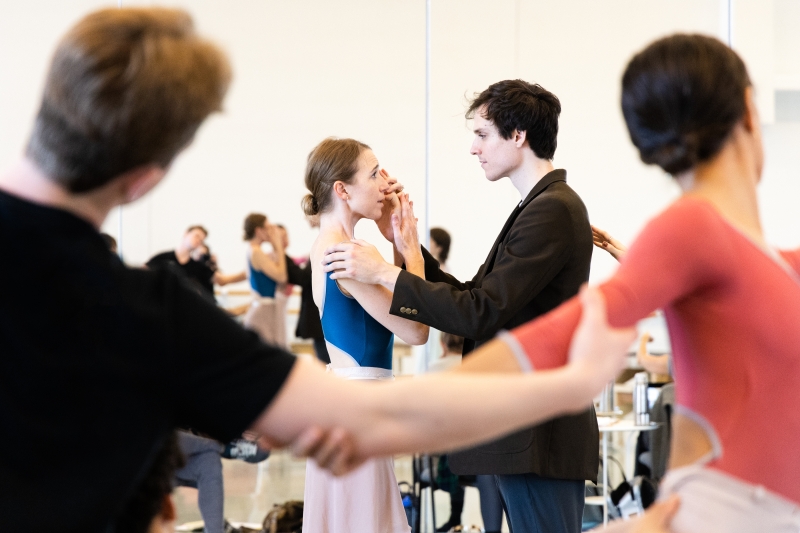
and Chase O'Connell with Artists of Houston Ballet
Rehearsing Choreographer Cathy Marston's SUMMER AND SMOKE
Photo by Lawrence Elizabeth Knox (2022),
Courtesy of Houston Ballet
SUMMER AND SMOKE is a Tennessee Williams play, and it's focused around these two characters, Alma and John. I play Alma in this production. The pair grew up as neighbors when they were really young kids, and as the ballet starts, you see them as children. Alma is the daughter of a minister, and her mother is mentally unwell, so she had to grow up and take care of her mother from a very young age. This has led her down this life of having to be responsible and in charge of her actions. In other words, she is a very "straight arrow" girl. John is the exact opposite! He is the son of the town's doctor, and he's very playful. He chooses Alma, and you pick up on that when they are kids right in the beginning. He goes away to medical school, and when he comes back, Alma and John are reacquainted as adults. That's where the story really takes off. You immediately sense that there is this connection between them, but they couldn't be more opposite in the ways that they view the world. Alma is very religious and soul-focused, whereas John is a man of science, and he believes that you have to fuel your mind, gut, and sensuality. So, the story is their journey of telling each other what is important about life and them slowly evolving as people. Alma starts to understand what John's priorities are and vice versa, and by the end of the ballet, they have both done a complete 180. Alma comes to him, ready for the relationship that he's been wanting, but by then, it is the wrong time for him. It is too late in a sense, and it is sad because they will never end up together. However, I think it's a really beautiful story in how everyone is open for change, and Alma ends up turning a new page where she is now more open and willing for love. It is not a happy ending, but it is not all heartbreak; it is just incredibly human.
Considering that this production is connected to a play text, when you all were working through the story in the rehearsal room, were you often going back to the play, or at that point, was the production development off of the pages? Did you ever read the play text yourself?
Cathy was very super descriptive from the start with our characters and the arc of the story. As soon as we would start a new scene, she would tell us what had happened at that point, what we were feeling, what emotions we needed to show within the dance we were about to create, and what we are feeling when we leave the stage. She was always super clear, detailed, and completely motivated by the story, the character, and the feelings. Therefore, many of us felt that we didn't need to read the play because she had given us so much context to work with. I chose to read it on my own time just because I wanted to; I wanted some dialogue in my head because I feel that it is easier to act sometimes when there are words to go off of. Cathy did follow the play text very closely, and this last time that she was in town, she also brought in a dramaturg from England (where Cathy is also from). He was also super helpful in making sure that our story was clear. He would ask us questions such as why Alma chose to say no or why she chose to walk in a certain direction. There was never a wrong answer; he was just helping us peel back the layers to understand what was motivating every piece of movement. It really operated like we were actors, which I loved.
SUMMER AND SMOKE is a world premiere occurring at Houston Ballet. How is the rehearsal process different with an original show like this versus a traditional show such as THE NUTCRACKER?
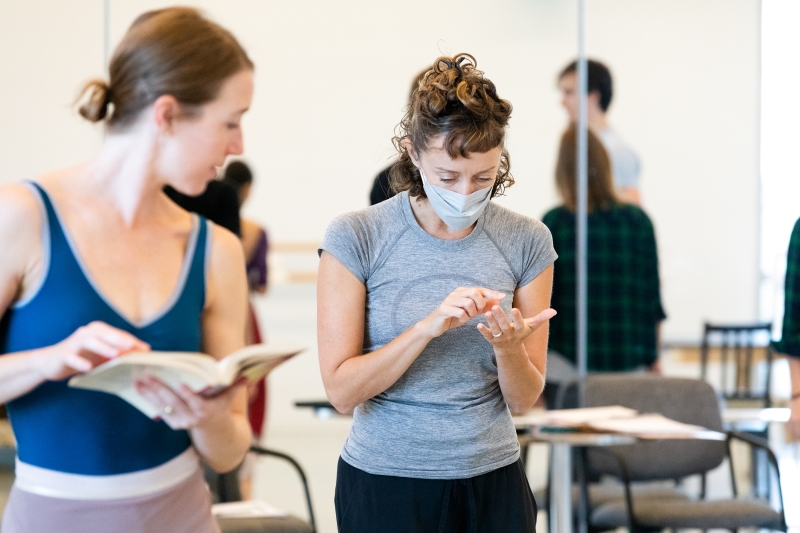
with Houston Ballet Principal Jessica Collado
Rehearsing SUMMER AND SMOKE
Photo by Lawrence Elizabeth Knox (2022),
Courtesy of Houston Ballet
THE NUTCRACKER, ROMEO AND JULIET, SLEEPING BEAUTY, SWAN LAKE....all of those ballets have this long history. There are tons of versions out there, and the story is pretty much consistent throughout all of them. SUMMER AND SMOKE is based on a play by Tennessee Williams, so that literature is out there, but there isn't much else other than that. There hasn't been a ballet created about this. I remember when we found out we were doing it, I was trying to do all of this research online to get as much information as I could about it. However, there wasn't a lot out there, which I loved because there was this open slate where we could create this new version and new way of expressing the story without other versions out there to inhibit our thoughts. Cathy Marston is the choreographer, and she is very well known for doing exactly this process: taking pieces of literature- poems, stories, and plays- and creating them into ballets. She is a wonderful storyteller, and her process of creating movement is very unique. The very first day that she came in, she sat us all down on the floor and told us our characters. She had built this long list of personality traits for each of us, and then we were asked to associate those traits with ballet steps. From there, we created this list of ballet steps that we used to create phrases. Each character has a phrase that is very much associated with their personality, and that's how she built the ballet. There are even times in the ballet where we do material from another character when we are talking about that person. The original music also follows that theme; each character has their theme of music, which comes in and out throughout the whole ballet.
I have read that the show is also a co-production with the American Ballet Theatre. How does that play into the development of the production?
When we do a co-production, it usually means that both companies are helping to fund the creation of the ballet. This is a huge piece. It has an original score, there's a whole set design that was created in Canada for it, it has new costumes...all of these wonderful elements that are coming together in this collaborative process. Also, Cathy Marston came and created the ballet here with us, and then she will travel to New York and work with American Ballet Theatre. Then, they will be premiering the ballet up in New York in the fall, so both companies get to enjoy a premiere in their own separate theaters.
How big of a cast does this production have?
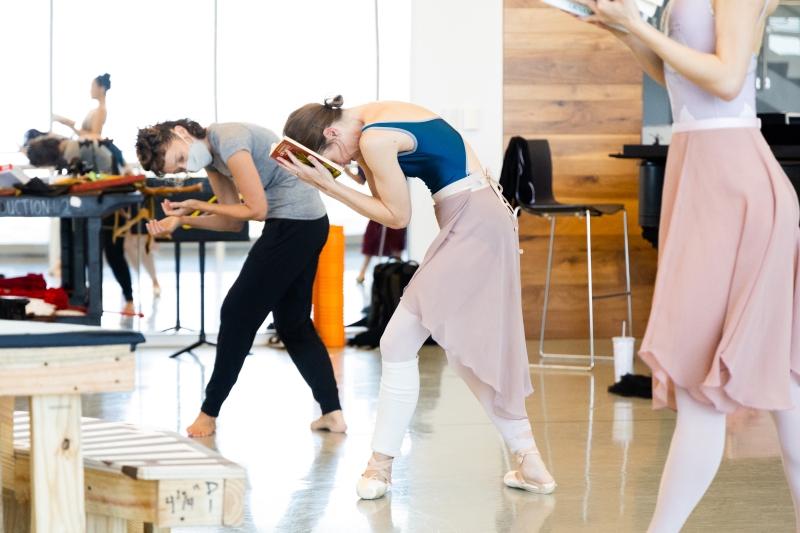
with Houston Ballet Principal Jessica Collado
Rehearsing SUMMER AND SMOKE
Photo by Lawrence Elizabeth Knox (2022),
Courtesy of Houston Ballet
There are 30 of us in the cast. There is Alma, John, their parents, and an ensemble that comes on as numerous people. They are townspeople, gamblers...At one point in the show, Alma goes to this fountain every day to pray, and she creates an angel character for guidance, help, and strength. Cathy decided to make the angel a dancer, so there is this angel dancer who has six angel chorus dancers that emulate her wings. They help guide the story throughout the whole ballet. I think of the angel character as Alma's conscience, but also, the angel character is rooting for Alma and John; she wants them to be together, so she goes through ebbs and flows of them trying to meet on the same page. She even shows her despair near the end of the show.
What does a typical day of rehearsal look like for you for this production?
Cathy was here for two chunks of time. She was here for three weeks back in October and then for two weeks back at the beginning of January to make this piece. When she was here, it is very immersive with SUMMER AND SMOKE. We would start the day with ballet class in the morning at 10:00 am, which was an hour and a half, and then we would have six hours of rehearsal. Depending on where she was in the story, we would sometimes have two studios going at the same time, and in one studio, she would be creating new material (chipping away at the scenes one by one), and then in the other studio, her assistant would be working on the moves she had just created and fine-tuning them, such as cleaning up counts with music and spacing. It's just a one-act piece, but it is a full hour ballet. In my mind, it is a three-act, full-length ballet without intermissions. It is definitely jam-packed with story and a lot of dancing!
What is your favorite part to perform and/or see in the production?
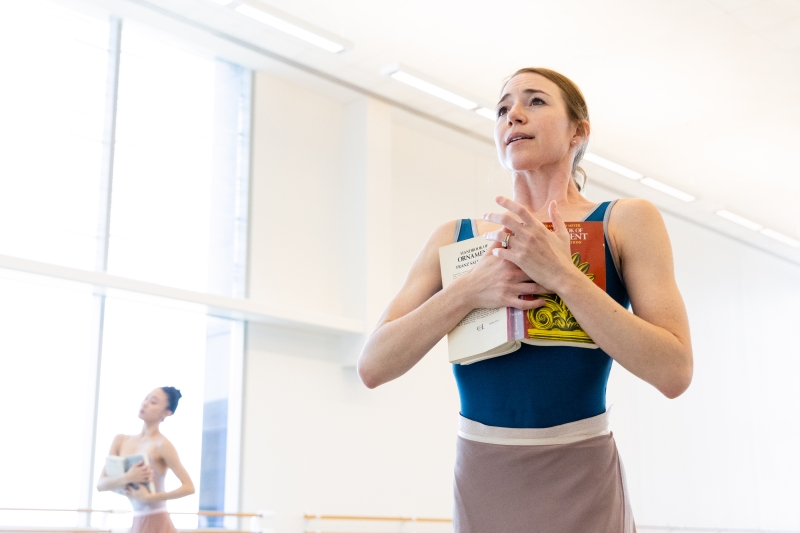
Rehearsing Choreographer Cathy Marston's SUMMER AND SMOKE
Photo by Lawrence Elizabeth Knox (2022),
Courtesy of Houston Ballet
That's hard! Alma starts as a very uptight, nervous character, and as the story evolves, she slowly sheds that and becomes more relaxed and open. The movement really shows that well. John and Alma do 6 dances with each other within the course of the ballet, which is a lot of dances together, and they each become bigger, more expansive, more open, and (I think) more fun. As the dances grow, they're more expressive, so I really enjoy the last one that we do at the end. It is Alma's final attempt at showing up for him and saying that she is ready if he will have her. It is a really beautiful, dramatic part of the music, and the moment culminates her as a character really well. That moment of dance also correlates with the character's famous quote from the play: "The girl who said 'no' - she doesn't exist anymore, she died last summer - suffocated in smoke from something on fire inside her." This line is my favorite quote from the whole play because it talks about the title, and it is saying that she has turned a new page...that she is no longer that girl anymore...that she is open and free in this beautifully expressive way. This line has such vivid imagery!
Are there any technical spectacles or design elements in this production that we can look forward to?
Yea! There was a mock-up of the set in the studio, and I am still waiting to see how it pans out onstage when we start our tech rehearsals next week. However, from what I have seen for the set, there is this platform that is probably three or four feet high with steps that cascade across the stage in the back. It is this way of dividing the space into two separate rooms; downstairs, it is like a church and upstairs is John's doctor's office. We sit on the stairs, we go up the stairs, we come down them...there's a lot of partner work that we do including the stairs where we jump off the stairs. I also heard that the shape of the platform was modeled after the Mississippi River, which is where the story is taking place. It really ties everything together! The lighting will also be really cool and creative in how they will illuminate the spaces at different times. Lastly, when it comes to costumes, the time period of the piece is the turn of the century, which would typically be three-piece suits for the guys. I believe that is what John is wearing (which might get a little warm)! Alma wears a yellow dress, and although our dresses aren't to the floor as they would typically be in that era, we've shortened them for dance so you can see movement. In that sense, they are more modern. I've only seen little glimpses of the costumes, but that is what I have seen so far!
To finish us off here, when and where can we see Houston Ballet's "Summer and Smoke"?
SUMMER AND SMOKE runs March 9th through the 19th, and you can get tickets at houstonballet.org. There are six performances of the performance, and SUMMER AND SMOKE is part of a "triple bill" with SUMMER AND SMOKE being its focus. A "triple bill" is when there are three different works on the program each night. SUMMER AND SMOKE is also paired with the neoclassical Concerto Barocco by George Balanchine and Clear by our Artistic Director, Stanton Welch. Both of these works are about 15-20 minutes long, and they will be performed first. Each evening will be concluded with SUMMER AND SMOKE.
Do not miss it! Buy your tickets HERE now!
Comments

Videos

